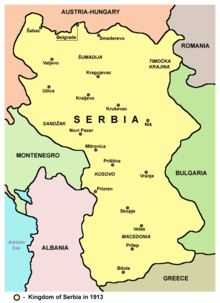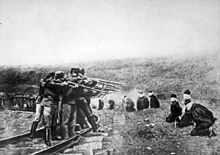
Vojvodina, officially the Autonomous Province of Vojvodina, is an autonomous province that occupies the northernmost part of Serbia, located in Central Europe. It lies within the Pannonian Basin, bordered to the south by the national capital Belgrade and the Sava and Danube Rivers. The administrative centre, Novi Sad, is the second-largest city in Serbia.
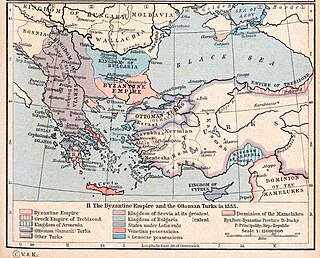
The history of Serbia covers the historical development of Serbia and of its predecessor states, from the Early Stone Age to the present state, as well as that of the Serbian people and of the areas they ruled historically. Serbian habitation and rule has varied much through the ages, and as a result the history of Serbia is similarly elastic in what it includes.

Đorđe Petrović, known by the sobriquet Karađorđe, was a Serbian revolutionary leader who led a struggle against the Ottoman Empire during the First Serbian Uprising. He held the title of Grand Vožd of Serbia from 14 February 1804 to 3 October 1813.

Central Serbia, also referred to as Serbia proper, is the region of Serbia lying outside the autonomous province of Vojvodina to the north and the disputed Kosovo region to the south. Central Serbia is a term of convenience, not an administrative division of Serbia as such, and does not have any form of separate administration.

The Yugoslav Committee was a World War I-era, unelected, ad-hoc committee. It largely consisted of émigré Croat, Slovene, and Bosnian Serb politicians and political activists whose aim was the detachment of Austro-Hungarian lands inhabited by South Slavs and unification of those lands with the Kingdom of Serbia. The group was formally established in 1915 and last met in 1919, shortly after the breakup of Austria-Hungary and the establishment of the Kingdom of Serbs, Croats and Slovenes, which was later renamed Yugoslavia. The Yugoslav Committee was led by its president, the Croat lawyer Ante Trumbić, and, until 1916, by Croat politician Frano Supilo as its vice president.

Peter I was King of Serbia from 15 June 1903 to 1 December 1918. On 1 December 1918, he became King of the Serbs, Croats and Slovenes, and he held that title until his death three years later. Since he was the king of Serbia during a period of great Serbian military success, he was remembered by Serbians as King Peter the Liberator and also as the Old King.
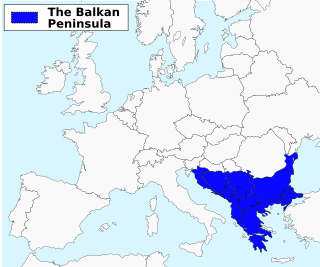
The Balkans and parts of this area may also be placed in Southeastern, Southern, Eastern Europe and Central Europe. The distinct identity and fragmentation of the Balkans owes much to its common and often turbulent history regarding centuries of Ottoman conquest and to its very mountainous geography.

The Kingdom of Serbia was a country located in the Balkans which was created when the ruler of the Principality of Serbia, Milan I, was proclaimed king in 1882. Since 1817, the Principality was ruled by the Obrenović dynasty. The Principality, under the suzerainty of the Ottoman Empire, de facto achieved full independence when the very last Ottoman troops left Belgrade in 1867. The Congress of Berlin in 1878 recognized the formal independence of the Principality of Serbia, and in its composition Nišava, Pirot, Toplica and Vranje districts entered the South part of Serbia.
Vojvodina is an autonomous province located in northern Serbia. It consists of the Pannonian Plain in the south, and the Danube and Sava rivers in the north.

The History of the Serbs spans from the Early Middle Ages to present. Serbs, a South Slavic people, traditionally live mainly in Serbia, Montenegro, Bosnia and Herzegovina, Croatia and North Macedonia. A Serbian diaspora dispersed people of Serb descent to Western Europe, North America and Australia.

The Serbian campaign was a series of military expeditions launched in 1914 and 1915 by the Central Powers against the Kingdom of Serbia during the First World War.
Foreign relations of Serbia are formulated and executed by the Government of Serbia through its Ministry of Foreign Affairs. Serbia established diplomatic relations with most world nations – 188 states in total – starting with the United Kingdom (1837) and ending most recently with Guyana (2024). Serbia has friendly relations with following neighboring countries: Montenegro, North Macedonia, Romania, and Hungary. It maintains colder, more tense relations with Albania and Croatia and to a lesser degree with Bosnia and Herzegovina and Bulgaria due to historic nation-building conflict and differing political ideologies.

The history of the Jews in Serbia is some two thousand years old. The Jews first arrived in the region during Roman times. The Jewish communities of the Balkans remained small until the late 15th century, when Jews fleeing the Spanish and Portuguese Inquisitions found refuge in the Ottoman-ruled areas, including Serbia.

Serbian nationalism asserts that Serbs are a nation and promotes the cultural and political unity of Serbs. It is an ethnic nationalism, originally arising in the context of the general rise of nationalism in the Balkans under Ottoman rule, under the influence of Serbian linguist Vuk Stefanović Karadžić and Serbian statesman Ilija Garašanin. Serbian nationalism was an important factor during the Balkan Wars which contributed to the decline of the Ottoman Empire, during and after World War I when it contributed to the dissolution of the Austro-Hungarian Empire, and again during the breakup of Yugoslavia and the Yugoslav Wars of the 1990s.

Anti-Serb sentiment or Serbophobia is a generally negative view of Serbs as an ethnic group. Historically it has been a basis for the persecution of ethnic Serbs.

Yugoslavia was a state concept among the South Slavic intelligentsia and later popular masses from the 19th to early 20th centuries that culminated in its realization after the 1918 collapse of Austria-Hungary at the end of World War I and the formation of the Kingdom of Serbs, Croats and Slovenes. However, from as early as 1922 onward, the kingdom was better known colloquially as Yugoslavia ; in 1929 the name was made official when the country was formally renamed the "Kingdom of Yugoslavia".
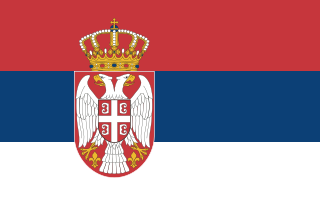
The following outline is provided as an overview of and topical guide to Serbia:

Yugoslavism, Yugoslavdom, or Yugoslav nationalism is an ideology supporting the notion that the South Slavs, namely the Bosniaks, Bulgarians, Croats, Macedonians, Montenegrins, Serbs and Slovenes belong to a single Yugoslav nation separated by diverging historical circumstances, forms of speech, and religious divides. During the interwar period, Yugoslavism became predominant in, and then the official ideology of the Kingdom of Yugoslavia. There were two major forms of Yugoslavism in the period: the regime favoured integral Yugoslavism promoting unitarism, centralisation, and unification of the country's ethnic groups into a single Yugoslav nation, by coercion if necessary. The approach was also applied to languages spoken in the Kingdom. The main alternative was federalist Yugoslavism which advocated the autonomy of the historical lands in the form of a federation and gradual unification without outside pressure. Both agreed on the concept of National Oneness developed as an expression of the strategic alliance of South Slavs in Austria-Hungary in the early 20th century. The concept was meant as a notion that the South Slavs belong to a single "race", were of "one blood", and had shared language. It was considered neutral regarding the choice of centralism or federalism.

The Austro-Hungarian Armed Forces occupied Serbia from late 1915 until the end of World War I. Austria-Hungary's declaration of war against Serbia on 28 July 1914 marked the beginning of the war. After three unsuccessful Austro-Hungarian offensives between August and December 1914, a combined Austro-Hungarian and German offensive breached the Serbian front from the north and west in October 1915, while Bulgaria attacked from the east. By January 1916, all of Serbia had been occupied by the Central Powers.

The Military General Governorate of Serbia was a military administration established by the Austro-Hungarian Army during the Austro-Hungarian occupation of Serbia. The Governorate existed from 1 January 1916 to 1 November 1918 during World War I. Along with Bulgarian occupied Serbia, it was one of the two separate occupation zones created after the Kingdom of Serbia was invaded and partitioned by the Central Powers.



